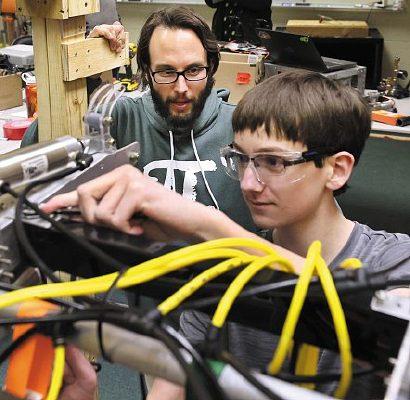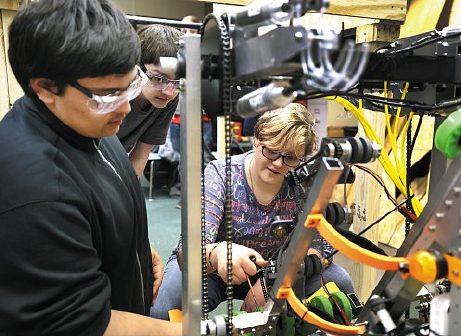
2 minute read
DeKalb teacher helpsstudents buildrobots competitively
By KATRINA J.E. MILTON | kmilton@shawmedia.com
During the school day, Michael Lofthouse teaches mathat DeKalb High School.
After work, he helps students use their mathematical knowledge toward real-life applications when participating in the DeKalb Crowbotics Team.
Eighteen students form acompetitive team, meeting 12 hours aweek after school to design and build robots. Thisyears’ team members are all DeKalb High School students, although eighth graders have made the cut in previous years.
“Thestudentslearn how to applytheir academic skills from the classroom into atechnical program,” Lofthouse said. “It’s STEM [Science, Technology, Engineering and Mathematics] in action.”
As theteam’s facultyadviser, Lofthouse said he oversees the students’ ideas and work, but he does so at adistance.
“It’s important for the students to take their ideas and run with them, for them to try and test out things,” he said. “Theyhave the abilitytodesign, build and redesign. Alot of failure willhappen, and thelearning process isn’t only what went wrong, but why. There’s not only aright and wrong way to do something. Problem-solving andteamwork are needed.”
Lofthouse and mechanical engineer Adam Van Boekel co-founded the DeKalbCrowboticsTeam in 2016. The robotics team was named after DeKalb’s mascot, Spike the crow.
“Theteamisteaching kids aconstructiveway to compete,” Van Boekel said. “This is one sport that everyonecan go pro, whether they become apro- grammer,designer or engineer. The teamisgreat because the students are learning alongsideprofessionals.”
Van Boekel was amemberofOswego High School’s robotics team when he was younger.
“I always liked mathematics, science and building stuff, and Itook those interests and turned it into a career,” VanBoekel said. “I like that there’s always more than one creative solution to aproblem. Science and technology are very broad fields. There’s a lot of directions you can take it and alot of jobs you can do utilizing the skills you learn.”
The DeKalb Crowbotics Team has been building a robot, nicknamed“Skeletor,” which competed at First Robotics Competition’s Midwest Regional April 6through 9atUIC’s Credit 1Arena in Chicago. The robot climbed ascending bars, similar to achallenge on the TV show“American Ninja Warrior.” The Crowbotics’ robot Skeletor advanced intothe quarterfinals and placed 26th out of 50 teams in the competition.
SophomoreBlake Bollow saidthat he joinedthe team because he hopes to one day haveacareer in engineering.
“I have a3Dprinter at home, and Ilike to design and build stuff forfun,” Bollow said.“Ijoined the team this year, and it’s been alot of fun. What’s cool about it is that everyone has different ideas and solutions. Everyone has adifferent way of how to approach the challenge. Every problem has multiple solutions.”
Junior Will Stamatakos joined the team his freshman year after moving to DeKalb from Sycamore.
“I’ve always been interested in robotics, and Ilike that youactuallyget to build arobot,not just learn about how to,” Stamatakos said.
Team Captain Leah Valentiner, asenior who has been on the team sinceshe was afreshman,said what keeps her involvedisthatshe is always learning new things.
•GOING
From page 13
“It’smore thananafter-school activity,” she said.“I’m constantly using things I’ve learnedinthe classroom and appliedthem to building a robot. Ilovelearning new things, and I learn something new every timeI’m here.”
Valentiner said that members of the team do all of the design process, with encouragement and assistance from the advisers as needed.
“We [students]get to do all of the design process,” Valentiner said.“It starts with our thoughts and ideas, then prototyping, designing, experimenting, building and then trial and error until we go to compete. …Everything is computer-based, involving technology, coding and logic.”
Lofthouse said thatthe students’ workbuilding arobottogetherasa team teaches them 21st-century skills.

“When Iwas younger, we had RC cars and that was it,” Lofthousesaid. “Now students have 3D printers, CNC machines andlaptops.They’re building robots that operate using code. The goal is that [as advisers], we’re aguiding hand that’s giving direction, and thestudents are the ones buildingthe robot. We’re helping the next generation get started,buildingasnowball that will only grow bigger and better over time.”







